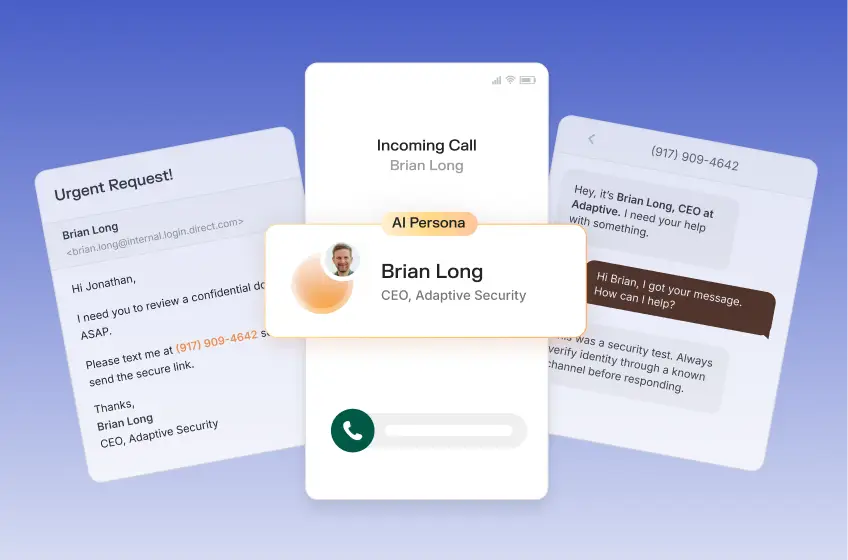Deepfakes aren’t just theoretical anymore. Now, they’re a daily reality for organizations in every industry worldwide.
AI-generated videos, images, and audio recordings are becoming increasingly indistinguishable from authentic content, allowing cybercriminals to manipulate, defraud, and misinform on a massive scale.
As synthetic threats, deepfakes circumvent traditional cybersecurity measures by exploiting human trust and institutional blind spots.
And it’s only getting worse. The number of deepfake videos online is increasing exponentially.
According to Surfshark research, there were just 22 recorded deepfake incidents from 2017 to 2022 in a sample study. That number almost doubled in 2023 and increased by 257% in 2024. Through the first quarter of 2025, last year’s annual total has already been exceeded by 19%.
It’s clear: Deepfakes are a fast-growing cybersecurity threat that IT and security teams can’t ignore.
To counteract this evolving threat, organizations need more than detection tools or phishing training alone. Instead, they require a structured, end-to-end deepfake protection framework that systematically addresses the full lifecycle of threats from initial assessment to advanced simulation and continuous improvement.
So, how can CISOs and security leaders implement deepfake protection? Here’s a practical framework aligned with Adaptive Security’s integrated, scalable approach.
Why Traditional Cybersecurity Fails Against Deepfake Attacks
Conventional cybersecurity defenses are designed to detect malware, ransomware, and unauthorized access. Sure, things like endpoint security and firewalls are highly effective in these areas.
What they can’t do is identify a deepfake. They’re not equipped to stop a fraudulent video of a CEO requesting a wire transfer or an AI voice clone leaving a message for an employee to reset login credentials.
Deepfakes exploit trust by evading filters and security protocols built for traditional threat vectors.
Several data points underscore this protection gap:
- Social engineering remains the origin of 98% of successful cybersecurity breaches.
- Deepfake-enabled fraud attempts have surged by 1,740% in North America within a year.
- Alarmingly, untrained individuals correctly identify deepfakes only 57% of the time.
Due to this precarious environment, organizations must transition from a reactive detection approach to a layered, proactive risk management strategy.
9 Essential Stages for a Deepfake Risk Management Framework
Adaptive Security’s approach provides a comprehensive roadmap for organizations seeking to systematically mitigate deepfake threats. The stages provide for business continuity, compliance, and operational realities.
Deepfake risk management framework stages
#1. Deepfake threat landscape assessment
To protect against deepfake attacks, organizations must first understand how these threats can materialize within their industry and operational environment. The process involves assessing any vulnerabilities related to high-value targets, key workflows, and potential misuse of public-facing content.
What should be considered at this stage?
- Identifying potential use cases for deepfake attacks within your sector.
- Reviewing high-profile employee exposure in public media.
- Monitoring how emerging regional threats could shift your risk landscape.
Adaptive Security’s real-time threat intelligence lets organizations track evolving threat vectors and adjust their defense priorities proactively.
#2. Organizational vulnerability analysis
Once you understand the threat landscape, the next step is to assess where your organization is most exposed. This type of analysis supports targeted mitigation, allowing you to effectively allocate resources.
A few key areas to evaluate include:
- The security of communication channels used for high-risk operations.
- The availability of public-facing media could help attackers create convincing deepfakes.
- Employee awareness and workflows that could be exploited.
Seeking the ideal resources to support your endeavors? Adaptive Security’s next-generation platform helps with vulnerability mapping and employee risk profiling to guide your strategy.
#3. Business impact quantification
Understanding the potential damage a deepfake incident can cause is an absolute must if you want to align your protection strategies with leadership and secure resources.
In this stage, organizations should:
- Estimate the financial impact of potential fraud facilitated by deepfakes.
- Assess reputational and operational risks tied to misinformation campaigns.
- Evaluate regulatory implications under frameworks like GDPR and SOX.
Adaptive Security’s impact modeling and ROI tools provide actionable data for leaders to prioritize their initiatives.
#4. Risk tolerance and compliance mapping
To ensure your deepfake mitigation strategies remain practical and enforceable in your operational environment, it’s essential to align them with both regulatory requirements and board-level risk tolerance.
Recommended actions that promote compliance include:
- Mapping relevant compliance requirements such as GDPR, HIPAA, and SOX.
- Documenting acceptable risk thresholds as approved by leadership.
- Identifying gaps in current policies and incident response playbooks.
Adaptive Security streamlines these processes with automated reporting and compliance mapping.
#5. Detection and prevention technology stack
Deepfake mitigation requires advanced detection and prevention systems that are integrated within your technology ecosystem. That way, threats are identified and blocked before they cause harm.
Here are some core components to consider:
- AI-driven detection tools for video, audio, and image analysis.
- Integration with SIEM and SOAR systems for contextual security event tracking.
- Real-time alerting systems for immediate awareness and response.
- Continuous learning models to adapt detection capabilities to evolving threats.
Adaptive Security embeds these capabilities within organizational workflows, which reduces the risk of successful synthetic media attacks.
#6. Security awareness training implementation
Employees are often the last line of defense against deepfake threats.
Training should go beyond generic awareness sessions, providing practical, role-based education that is continuously reinforced.
Organizations should implement:
- Microlearning modules that maintain awareness over time.
- Scenario-based training tied to realistic deepfake use cases.
- Phishing simulations using synthetic media to test employee readiness.
- Clear escalation pathways for reporting suspicious content.
- Regular updates to training content to reflect new attack patterns.
- Metrics tracking to measure training effectiveness and engagement.
If you want to maximize impact with adaptive learning paths that align with employee risk profiles, you can employ Adaptive Security’s tools to meet your goals.
#7. Deepfake simulation and testing programs
Simulation is crucial for evaluating the effectiveness of your detection and response strategies. It lets teams identify weaknesses before real-world incidents occur.
Testing should include:
- Controlled simulations of deepfake phishing and voice attacks.
- Red team exercises targeting sensitive workflows.
- Post-simulation debriefs to identify improvements.
- Employee participation in response drills.
- Tracking of detection and response times during exercises.
Adaptive Security paves a path to success. The platform enables hyper-realistic and personalized phishing simulations for comprehensive readiness assessment.
#8. Incident response and recovery planning
Even with detection and prevention systems in place, incidents can still occur. Having a deepfake-specific incident response plan helps your team react quickly and effectively.
Organizations should take steps such as:
- Develop detailed playbooks covering various deepfake scenarios.
- Define clear escalation and communication processes.
- Establish evidence collection and forensic protocols.
- Train teams on execution through periodic drills.
Adaptive Security integrates incident response workflows within its platform for swift, coordinated action.
#9. Continuous monitoring and improvement
Deepfake protection requires ongoing vigilance to adapt to evolving threats and maintain organizational resilience.
A few key activities include;
- Monitoring threat intelligence feeds for new attack techniques.
- Regularly updating incident response plans and training content.
- Measuring and tracking key performance indicators tied to detection and employee readiness.
- Participating in peer learning and industry information-sharing initiatives.
Adaptive Security’s continuous monitoring dashboards and predictive analytics support this iterative process.
Deepfake detection and prevention tools and features
Building Your Deepfake Defense Roadmap: Implementation Priorities
Developing a deepfake protection program is most effective when approached in phases that align with organizational readiness and risk priorities.
The following steps will help along the way:
- Initiate quick wins by deploying detection tools in key communication channels.
- Launch targeted security awareness training campaigns.
- Progress to advanced phishing simulation programs to validate readiness.
- Integrate deepfake response into broader incident management processes.
- Build long-term resilience through system-wide automation and monitoring.
Adaptive Security partners with organizations to develop tailored implementation roadmaps that align with their evolving security postures.
The Future of Deepfake Protection: Staying Ahead of Evolving Threats
Deepfake technology is advancing rapidly, so organizations must maintain adaptive, forward-looking defenses.
Future strategies will integrate advanced AI detection, cryptographic media verification, and continuous workforce education to counter increasingly sophisticated threats from synthetic media.
Still, over 80% of companies currently lack formal protocols to detect or respond to deepfake attacks. That leaves them vulnerable to synthetic identity fraud, phishing, and misinformation incidents
As organizations strengthen their layered defenses, they’ll be able to better protect their people, data, and brands, all while maintaining trust and operational continuity in a rapidly changing environment.




We are a team of passionate technologists. Adaptive is building a platform that’s tailor-made for helping every company embrace this new era of technology without compromising on security.
Contents



Want to download an asset from our site?





.avif)


.avif)
.avif)
%20(1).avif)



